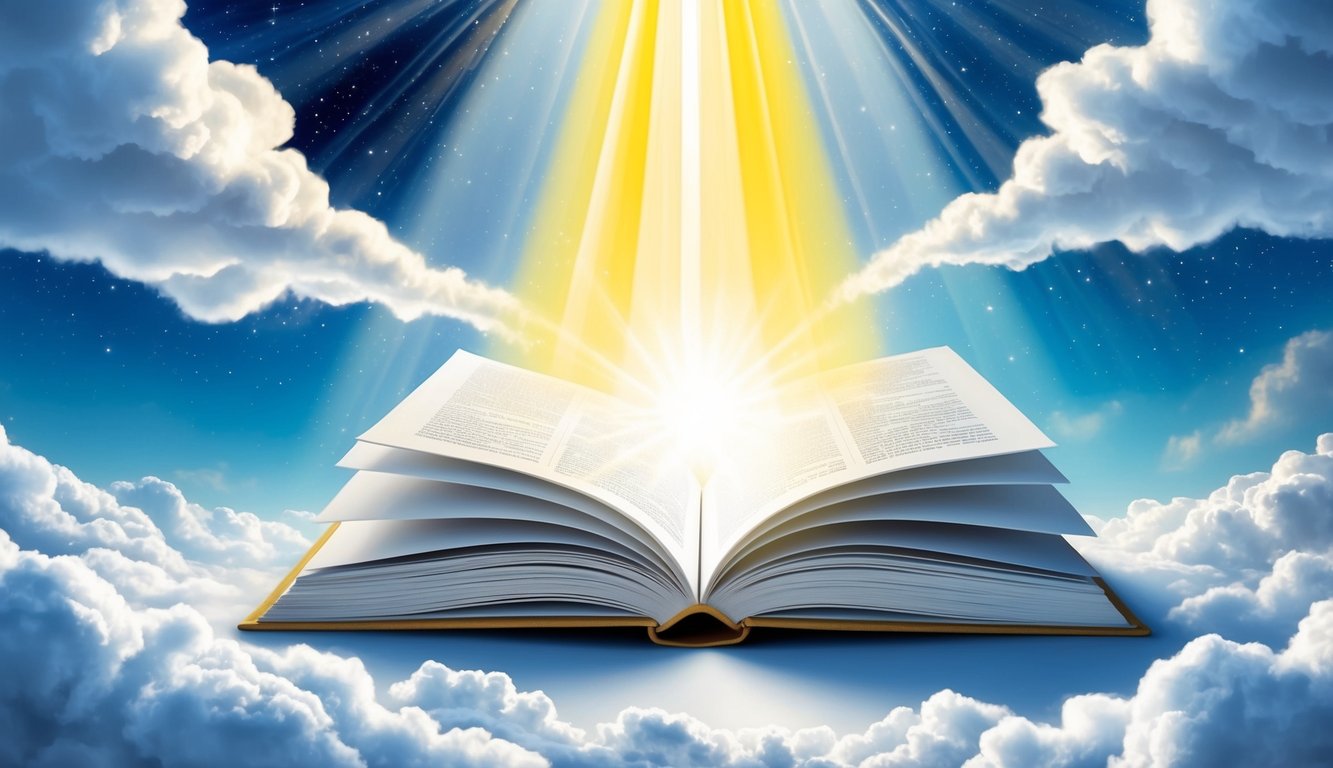Don’t Miss Out On This Unique Astrological Opportunity
Are you tired of spinning your wheels and getting nowhere? Simply put, you’re out of sync: you’re out of alignment with your astral configuration.
But: there’s a kind of map that can help you reclaim your alignment. Think of it as your own personal blueprint to success and happiness: a blueprint that will help you live your most amazing life.
Get started here.
Exploring the concept of the rapture within scripture can be both fascinating and complex.
Many people wonder what the Bible actually says about this event. The key idea often highlighted is the anticipation of Christ’s return and the gathering of believers. This topic has captured the attention of theologians and believers for centuries, leading to various interpretations and teachings.
In the scriptures, the rapture is often discussed in prophetic terms. Different texts throughout biblical history have approached it with unique perspectives, showing both pretribulational and premillennial views.
These interpretations shape how people live their lives in anticipation, often emphasizing readiness and faithfulness.
As you dive deeper into these passages, understanding both historical and modern viewpoints can offer a richer perspective on this often-debated event.
Whether looking at traditional teachings or exploring fresh insights, the discussion around the rapture invites you to consider its impact on faith and daily living.
Key Takeaways
- The rapture relates to Christ’s return for believers.
- Biblical texts offer varied interpretations of the rapture.
- Studying scripture encourages readiness for the rapture.
Biblical Foundations of the Rapture
The concept of the rapture involves various scriptures, focusing on themes of Jesus Christ’s return, resurrection, and hope for believers.
By examining prophecies and revelations, you can better understand its biblical foundations.
Old Testament Prophecies
In the Old Testament, texts like Daniel provide early clues about the rapture.
Daniel speaks of visions where the Son of Man plays a central role in end-times events.
These passages refer to a time when the faithful would awaken, rising to everlasting life.
The prophetic imagery of Resurrection in Daniel sets the stage for further revelations in the New Testament.
The book of Daniel emphasizes justice and the ultimate triumph of God’s kingdom.
While the term “rapture” is not directly mentioned, the theme of a gathering or awakening of the faithful offers a basis for understanding future expectations.
New Testament Revelations
In the New Testament, the idea of rapture becomes clearer, especially in the gospels and Revelation.
The book of Matthew presents Jesus Christ foretelling the gathering of the faithful when the Son of Man appears in the clouds.
Jesus talks about a time when believers will be taken up, separated from others, which many interpret as the rapture event.
The Book of Revelation, written by John, depicts vivid scenes of the end times, where the faithful are united with Christ in glory.
This account fuels much of the rapture interpretation today.
While interpretations vary, Revelation adds critical details to the framework of rapture beliefs.
Many scholars and believers turn to a Bible concordance for scripture study to cross-reference Revelation with other prophetic passages, seeking deeper understanding.
The imagery of tribulation, judgment, and ultimate redemption in Revelation has led to differing perspectives on the timing and nature of the rapture.
Despite these variations, its message of hope and victory remains central to Christian eschatology.
Thessalonians and Pauline Epistles
The writings of Paul, especially in 1 Thessalonians, provide essential insight into the rapture.
Paul comforts believers by explaining that the Dead in Christ will rise first when the archangel’s trumpet sounds.
He describes it as a time when those who are “asleep” in Christ will awaken and join the living to meet the Lord.
Paul emphasizes the hope of believers, assuring them that being alive or “asleep” does not change the promise of being gathered in faith.
His letters to the Thessalonians are a rich source of information on the rapture, providing clarity and assurance to early Christians.
Paul’s teachings blend theological insights with practical advice, helping believers understand their future in Christ.
Descriptions of the Rapture Event
In exploring the Rapture, two key moments stand out: the actual event and the signs and wonders that might accompany it.
These elements are deeply rooted in biblical descriptions and interpretations that offer a vivid portrayal of this supernatural event.
The Moment of Rapture
During the Rapture, believers are described as being “caught up” to meet the Lord in the clouds.
This event is often associated with the voice of the archangel and the sound of a trumpet signaling the event.
In an instant, known as the “twinkling of an eye,” the living and the dead in Christ are transformed.
The dead are raised imperishable, while the living become immortal.
This transformation is a key aspect of the Rapture.
It’s believed to show God’s power and glory, setting the stage for the eventual Second Coming, where believers meet the Lord in the sky.
Signs and Wonders
The Rapture is expected to be preceded by various signs and wonders.
Many people refer to Revelation 1:7 which speaks of Christ coming with the clouds, visible to all.
Such descriptions emphasize the power and drama associated with this event.
Osome interpretations, signs can include natural disturbances or miracles showing God’s intervention.
These wonders serve to alert believers and non-believers alike to the arrival of this profound event.
Timely predictions and unexpected happenings may act as harbingers for the Rapture, further adding to its mystery and significance.
The Timing of the Rapture

The timing of the Rapture is a topic that offers various perspectives, primarily on when this event might occur concerning the tribulation period.
Some believe in its sudden, unpredictable nature, aligning with teachings about being ever-watchful.
Views on Tribulation and Rapture
Different beliefs exist regarding the Rapture’s timing in relation to the tribulation.
The pre-tribulation view suggests the Rapture occurs before the tribulation, sparing believers from the Day of the Lord and its hardships.
Meanwhile, others propose a post-tribulation view, where the Rapture happens at the end of the tribulation, aligning with descriptions of Jesus descending from heaven in great glory, mentioned in Matthew 24:36 and 1 Thessalonians 5:2.
Understanding these perspectives helps in grasping why the timing remains a subject of debate.
Each stance interprets biblical passages differently, often referring to the same scriptures.
The significance of preparing a place is emphasized in varying contexts, shaping how believers anticipate the Rapture.
The Imminence of the Rapture
The idea of the Rapture being imminent means it could happen at any moment, as depicted by the metaphor of a Thief in the Night.
This interpretation is drawn from verses like Mark 13:32, highlighting the unpredictable hour of the event.
In Luke 17:34-37, signs accompanying the Rapture are not precisely outlined, adding to its mystery.
This belief encourages constant readiness among believers, urging them to stay vigilant.
Preparing involves living a life of faith and observance, as the exact timing remains a divine secret.
The notion creates an expectation of suddenness, pushing individuals to be spiritually prepared.
Living in Anticipation of the Rapture

Living in anticipation of the rapture involves watchfulness and finding hope in scriptures.
The faithful are encouraged to be alert and derive comfort from the promise of salvation and Christ’s return.
The Call to Watchfulness
Scriptures emphasize the importance of being watchful for the rapture.
In 1 Thessalonians 5:6, believers are urged to stay awake and be sober.
This means keeping a vigilant eye on world events and spiritual readiness.
Christ told his disciples that the exact time of his return is unknown, likening it to a thief in the night.
This calls for constant readiness and prayer.
Churches today continue to encourage their members to live in a state of watchfulness, aligning their lives with God’s teachings and commandments.
You are invited to nurture faith in anticipation of this divine event.
Embracing Hope and Comfort
The promise of the rapture offers immense comfort and hope.
John 14:3 highlights Christ’s assurance to return and bring believers to an eternal place prepared for them.
This underscores the theme of salvation, offering peace amid life’s uncertainties.
The idea of being united with Christ provides a deep sense of purpose and reassurance.
Many saints look forward to the angelic call that will mark this transformative event.
In 1 Thessalonians 4:18, followers are encouraged to support each other with these words.
Embrace this hope by participating in worship and community, knowing that as part of this global faith, you are not alone on this journey.
Frequently Asked Questions

The concept of the rapture involves various interpretations and ideas in biblical scripture.
Key questions often arise around its description in different books of the Bible and its connection to events like the Second Coming.
What happens during the rapture according to biblical scripture?
The rapture refers to the belief that believers will be taken up to meet Jesus in the clouds.
This event is seen as a gathering of all Christians, both living and deceased, to be with Christ forever.
How is the rapture described in the Book of Revelation?
The Book of Revelation is full of symbolic language and imagery.
While it does not explicitly mention the word “rapture,” the idea is often associated with events like the gathering of believers before the tribulation.
Which verses in Thessalonians discuss the concept of the rapture?
First Thessalonians 4:16-17 is among the prominent verses discussing the rapture.
These passages talk about the Lord descending from heaven and believers being caught up together with them in the clouds.
What does the Bible say about the Second Coming and its relation to the rapture?
The rapture and the Second Coming are closely linked but separate events.
The rapture is believed to occur before a time of tribulation, while the Second Coming involves Christ returning to earth to establish His kingdom.
What is the rapture and how is it explained biblically?
Biblically, the rapture is explained as a future event when Jesus will call all Christian believers to join Him in heaven.
It signifies a time of hope and promise for those who follow the teachings of Christ.
In Corinthians, what verses refer to the idea of the rapture?
First Corinthians 15:51-52 speaks to the mystery of the rapture.
It describes a moment when believers will be changed “in a flash, in the twinkling of an eye.” This transformation is part of the promise of eternal life.



